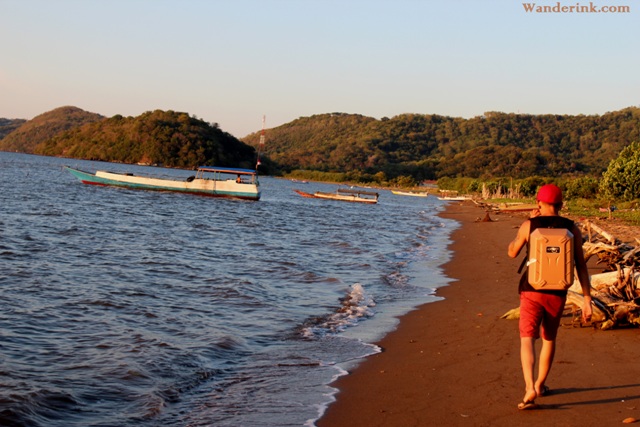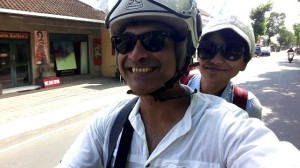“13,466,” said the UN.
“17,504,” claimed Indonesia.
The 4,000-odd in between were mostly atolls and a concatenation of minor cays which disappeared during high tide, countered the UN, basing its findings on a GIS survey conducted in 2011. Hence can’t be counted as islands proper. Take these few thousands, Indonesia still remains the largest archipelago in the world. And come high tide or low water, there are around 7,000 islands inhabited round the year. But for most who actually live here these are just numbers, shrug-vague at best. What matters more are the tide charts – around which they weave their family visits and ceremonies and even fix prices of essential commodities.
Stilted wonders
“We get these tide charts once every month,” someone told me outside the Banyan Tree Temple in Senggarang.
The fishing village of Senggarang on the island of Bintan is believed to be the earliest Chinese settlement in the country. The afternoon I walked along the concrete pathway that wound through its centre, the whole hamlet on piles seemed to be sleeping. Just a couple of children with smooth skin and sinic features stood by a doorway to a freshly painted palafitte, twiddling with the curtain. They ran away shrieking when my camera snout edged towards them. I made up by photographing a Vespa parked in the balcony, painted a peeling red and yellow, which would have seen more transplants than a reality TV star. I was on my way to the Banyan Tree Temple where locals congregated for gossip and caught up over kreteks, clove cigarettes. All around me was the glistening, viscous muck, the aftermath of a low tide, baring the visceral remains of disposable living.
“As you can see its low tide now and the high tide is around five hours away,” my initiation into the tide-chart-determined way of life continued outside the temple. Though fishing isn’t quite tide-dependent, incoming tides generally made for generous baits. Hence low tide was largely resting time, explaining the somnolent air.
While boating through the mangroves of Bintan the next day, Didi my sedulous and smiley guide cum conservationist pointed out a strip of land on the Sebong River. On it was a house fixed to stilts which was in turn fitted on to pontoons.
“Now that’s an island which will disappear, like, maybe twice a day,” said Didi. “But not the people,” he added seriously.
Despite its frequent vanishing acts, the island had to be counted as an inhabited one, I thought.
Now, what would the UN make of that!
Saw many zeroes
The obfuscatory devices of international money flows, valuations and speculations, I was rendered a millionaire in Indonesia. The cheap thrill was soon cut short by the pragmatic requirements of everyday transactions.
“There are too many zeroes on the currency notes,” agreed Manish Ranjan, operations manager with Plataran, a leading network of hotels and resorts. “On my first day at work I gave a 100,000 rupiah note for a pack of cigarettes and went away as I found the chaffering too confounding.” The next day as he walked to office the shopkeeper called out to him and tendered him the exact balance.
“A rare occurrence had it been our country,” he told me. Though Manish is from Bihar I couldn’t have agreed more.
Not only are the people so endearingly scrupulous but are endowed with bottomless reservoirs of patience too. My earliest dealings involved the rather twonky approach by which the shopkeeper would display for my benefit the note I was required to part with. Even then I’d get it all mixed up giving two of the green notes instead of one with the bluish-green tint. They would always return the extra note pointing out the additional zeroes on it with a gentle chiding laugh.
Glad they know us for our Bollywood heroes and not as inventors of the zero.
The quest for ‘cream chukkur’
Coming from the mall-magnet Delhi I turned down offers from my hosts to accompany me when I went shopping in the famous Sarinah Mall in Sabang, Jakarta. I had seen bigger and better, I assured them cockily. The batik-work shirt for the Indonesian Independence celebrations the next day I picked up without incident. Now for the shaving cream. I went to the toiletries section and fanned my face with a clenched fist at the retail attendant. She smiled very sweetly and handed me a rounded tinny box with a lot of foamy Indonesian letters sprawled over it.
“Terima kasih,” I said with a bow of my head. Thank you. And the best way to elicit some dazzling smiles.
“Sama sama,” she replied. Welcome. With a dazzling smile.
It had been a long day: Earlier I was at the Botanical Gardens in Bogor, the Presidential Palace, Jakarta Cathedral and trotted around the gargantuan Istiqlal Mosque. So my face could have been tanned and oleaginous for the toiletry turned out to be face wash. Over the next few days I tried my best imitation of Chinese tea ceremony in different shops and was rewarded variously with moisturising lotion, sunscreen and talcum powder. Conceding defeat I sought linguistic asylum from my host.
‘Cream chukkur,’ he said and I duly noted it down prior to my next shaving cream raid. This time at the Rimba Jaya Night Market in Bintan.
From Rimba Jaya where we stopped for dinner I walked a few kilometres and reached Jalan Brigjen Katamso, a picture of civic calm and all-around amiability. Well, like the rest of Indonesia, actually. First I walked into an apotik, a medical store. They directed me to a supermarket some distance away. At checkout my eye welled up as I showered ‘Terima Kasihs’ to everyone around me – they were stocking not one but two different brands of shaving foams!
This was indeed a rare occurrence as I learnt later that Indonesians have smooth facial hair which dispenses with the need for a vigorous lather.
Traffic wows
Jakarta is as trafficky as any bustling metropolis and during peak time commuters may take hours to reach. Many businessmen have fitted their SUVs with portable work stations to make the most of the time on the road. Ojeks, two-wheeler taxis and the fastest way to travel, flit through, buzzing flies. The lines snake for long distances from intersections. For an Indian all this order amidst the chaos can be maddening: not one solitary vehicle, even those with laal battis, skipped lane discipline. Neither will an ojek try to cut ahead of you. The left lane is kept free at all times. I was missing the clutter, the cussing and the incessant honking. Heading out to Ubud from Kuta in Bali I reached my wits’ end and turned to Agung Rai, tour guide, for help.
“There are rules, alright,” he said. “But we listen to our hearts.”
That is Indonesia in short: a lot of heart, worn mostly on the cuff. And it would grow on me, holding me in good stead during my stay there.
Hopefully afterwards too.



















Keep em coming. Your view of the land is definitely a refreshing change from the usual dour monologues of the travelling kinds
I try…hard…to please :)) But thank you very much Austin!